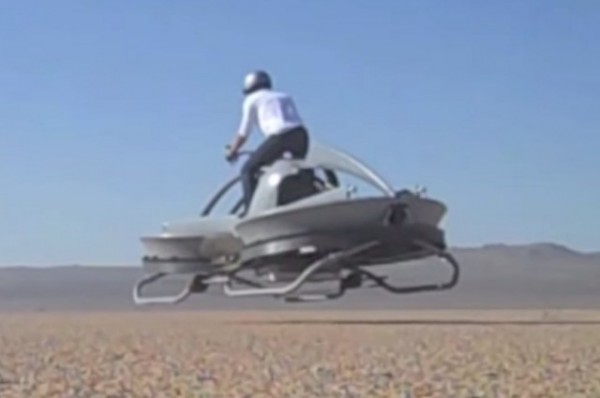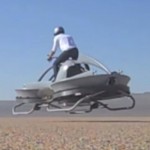
No matter what anyone tells you, it is never too early to make your Christmas list for 2017. California-based tech company Aerofex has developed the Aero-X hovercraft that is slated to undergo flight tests in 2016 and—assuming no setbacks—they will hit the market in the US in 2017. They are expected to go for about $85,000. If you would like to be one of the first to get your hands on the Aero-X (or if you would like to sponsor a certain IFLScience writer…) you can reserve yours now for only $5,000 down.
The Aero-X hovercraft rides like a motorcycle and allows two riders with a combined weight of 140 kgs (310 lbs) to ride in tandem. After completing a vertical takeoff, riders can cruise at speeds of 72 km/h (45 mph) up to 3 meters (10 feet) off the ground. The rotary engine uses standard automotive gasoline and runs for about 1.25 hours per tank. That might seem a bit low, but gas mileage was the tradeoff for carbon fiber rotors that are easier to control and much cheaper than traditional aircraft rotors.
Safety is an obvious concern with this vehicle and Aerofex has covered all the bases. The rotors are shrouded in ducts that permit airflow while preventing accidental contact with property or body parts, and it also contributes to a boost in lift. Redundancies in the controls and engine allow the vehicle to keep running smoothly and come to a controlled stop, even if something goes wrong during flight. Sway bars will give added stability and resist rolling while making tight maneuvers, while computerized sensors will automatically adjust the rotors when faced with strong gusts of wind. For an added layer of protection, there is an option to add airbags throughout the vehicle.
The Aero-X will not require a pilot’s license, though individual states may require certification, similar to the process required for boats and other off-highway vehicles like quads, dune buggies, or snowmobiles. As the Aero-X is unique in that it needs to be controlled in three dimensions, there is a bit of an adjustment period for the pilot to fully handle the vehicle with confidence.
As badass as this machine sounds, it does have practical purposes. It could be used by search and rescue crews, border patrol, and first responders to access areas that are hard to traverse on foot or with other modes of transportation.
Check out these videos of the Aero-X in action. If you’ll notice, they obviously kick up some dust and debris, but it is all diverted away from the pilot’s face.
360-degree view of Aero-X:








 Photographer Finds Locations Of 1960s Postcards To See How They Look Today, And The Difference Is Unbelievable
Photographer Finds Locations Of 1960s Postcards To See How They Look Today, And The Difference Is Unbelievable  Hij zet 3 IKEA kastjes tegen elkaar aan en maakt dit voor zijn vrouw…Wat een gaaf resultaat!!
Hij zet 3 IKEA kastjes tegen elkaar aan en maakt dit voor zijn vrouw…Wat een gaaf resultaat!!  Scientists Discover 512-Year-Old Shark, Which Would Be The Oldest Living Vertebrate On The Planet
Scientists Discover 512-Year-Old Shark, Which Would Be The Oldest Living Vertebrate On The Planet  Hus til salg er kun 22 kvadratmeter – men vent til du ser det indvendigt
Hus til salg er kun 22 kvadratmeter – men vent til du ser det indvendigt  Superknepet – så blir snuskiga ugnsformen som ny igen!
Superknepet – så blir snuskiga ugnsformen som ny igen!  Meteorite That Recently Fell in Somalia Turns Out to Contain Two Minerals Never Before Seen on Earth
Meteorite That Recently Fell in Somalia Turns Out to Contain Two Minerals Never Before Seen on Earth  Nearly Frozen Waves Captured On Camera By Nantucket Photographer
Nearly Frozen Waves Captured On Camera By Nantucket Photographer  It’s Official: Astronomers Have Discovered another Earth
It’s Official: Astronomers Have Discovered another Earth 